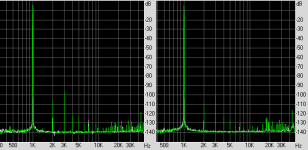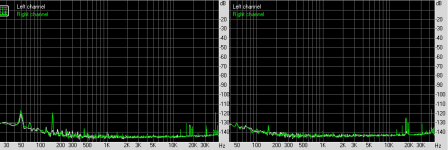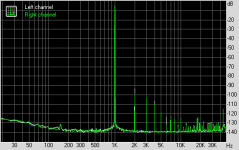Happy new year to you too! Without your help with SA1016/SC2362, I'd never be happy with the amp. I'm still very grateful. So what Sanyos are you proposing? I can't fit anyting larger than TO-126 on this board, but if I lay out a new one, I'll make room for TO-220. I've tried SA1538/SC3953, but they can't take even 20 mA of current.Sigurd Ruschkow said:Nelson,
the full schematic I have of the AD797 is similar to what you have drawn but differs a bit.
I would add cascoding of the input stage JFETs.
I would also try some other BJTs for the output stage. Sanyo has some very good medium current BJTs that you might want to try.
Happy New Year!
Sigurd
Regarding cascoding the input, I have six fairly matched SK246 waiting for some experimenting. I just haven't tried it yet. It'll be very hard to improve on the sound of this amp since it sounds so very close to perfect. I think I'll experiment with the AD829 clone first since it sounds grainier, and improvement should be easier to hear. I'm also going to try CFP input and maybe the combination of CFP and cascodes.
I don't understand. In what respect do they fall down when pushed to 20mA?nelsonvandal said:I've tried SA1538/SC3953, but they can't take even 20 mA of current.
I can't understand it either. When biased to 20 mA the sound was colored. Like a glaze over everything. With heavy loads (10R), it started to clip at moderate levels. When I lowered the bias to something like 6 mA, the sound was less colored, but it was still clipping at moderate levels when loaded down.AndrewT said:I don't understand. In what respect do they fall down when pushed to 20mA?
Maybe it has to do with the low voltage supply, 10 V, but when using BD137/BD138 (ONSemi) there are no problems at all. I know the BD's sound slightly darker than neutral when I've used them in open loop diamond buffers, so I had great hopes for an improved sound with the Sanyos. I've used BC639/640 from ONSemi in this amp but they sound muddy in comparison. I don't know if I should try BC639/640 from NXP. I'm quite happy with the sound as it is at the moment.
Nelson,
we have discussed this matter recently, you have a very short memory, don’t you? The Sanyo devices are inappropriate for that job, just like Mr. Carr insightfully pointed out. Use 2SC5171 or 2SC4793, if not possible 2SC3421 or 2SC2824.
we have discussed this matter recently, you have a very short memory, don’t you? The Sanyo devices are inappropriate for that job, just like Mr. Carr insightfully pointed out. Use 2SC5171 or 2SC4793, if not possible 2SC3421 or 2SC2824.
10ohm loading!!!nelsonvandal said:
I can't understand it either. When biased to 20 mA the sound was colored. Like a glaze over everything. With heavy loads (10R), it started to clip at moderate levels. When I lowered the bias to something like 6 mA, the sound was less colored, but it was still clipping at moderate levels when loaded down.
What happened to 300ohms?
6mA bias allows almost 12mA peak output for ClassA working.
That's just 120mVpk maximum output (0.7mW into 10r). Then it goes into ClassAB working and from the graphs starts to go off @ about 90mA. That's only 900mVpk and equivalent to just 40mW of ClassAB output into 10r.
That was just for testing it's abilities. It should be able to handle any kind of headphones, including 16R IEMs. Listening tests is done with 300R Sennheiser HD650. There's no sonic benefits of using the Sanyos before the BD's even when driving a light load such as the HD650.AndrewT said:10ohm loading!!!
What happened to 300ohms?
I don't know what signal level you use to drive the 300ohm headphones, but if one applies the usual worst case speaker loading to your headphone amplifier you will find that your +-5V supply could possibly be stretching the followers even into a 300ohm reactive load.
eg.
maximum output current ~Vpk/Rload/0.35.
for 4.5Vpk output into 300ohm speakers the maxmimum current could be ~= 4.5/300/0.35 ~= 43mApk. This is equivalent to ~33mW into 300r.
To remain in ClassA the bias would need to be set to >22mA.
Now the followers will be running warm to hot. Apply the temperature de-rating and you are really stretching these 100mA/200mA devices.
If your actual loading were 300r (resistive) then the operating conditions on the followers are in a completely different ballpark.
Decide what you're designing and then select devices appropriately.
Is this discrete opamp for 300r or 300ohm or 10r or 10ohm?
I note you kept headphone amplifier as the duty from us until post17, naughty!
eg.
maximum output current ~Vpk/Rload/0.35.
for 4.5Vpk output into 300ohm speakers the maxmimum current could be ~= 4.5/300/0.35 ~= 43mApk. This is equivalent to ~33mW into 300r.
To remain in ClassA the bias would need to be set to >22mA.
Now the followers will be running warm to hot. Apply the temperature de-rating and you are really stretching these 100mA/200mA devices.
If your actual loading were 300r (resistive) then the operating conditions on the followers are in a completely different ballpark.
Decide what you're designing and then select devices appropriately.
Is this discrete opamp for 300r or 300ohm or 10r or 10ohm?
I note you kept headphone amplifier as the duty from us until post17, naughty!
nelsonvandal said:
That was just for testing it's abilities. It should be able to handle any kind of headphones, including 16R IEMs. Listening tests is done with 300R Sennheiser HD650. There's no sonic benefits of using the Sanyos before the BD's even when driving a light load such as the HD650.
Looks good Nelson. I had the same idea when I started that discrete OPA627 thread which I am still working on. I was gifted with some HD600's.
You may look into cascoding T1 and connecting the collectors of the first drivers in the output stage back to the output. This works in IC's but some discretes don't like running that close to saturation.
With high bias you might not find a lot of benefit to the distortion neutralization.
I was thinking of some video Sanyo BJT:s as I thought you were making a line amp, but as you want to drive low Z headphones my suggestions no longer are valid. For low Z headphones I would try the 2SA1837/2SC4793 as Jonathan suggested.
You can use the SA1016/SC2362 for cascode work, too.
Sigurd
You can use the SA1016/SC2362 for cascode work, too.
Sigurd
nelsonvandal said:
Happy new year to you too! Without your help with SA1016/SC2362, I'd never be happy with the amp. I'm still very grateful. So what Sanyos are you proposing? I can't fit anyting larger than TO-126 on this board, but if I lay out a new one, I'll make room for TO-220. I've tried SA1538/SC3953, but they can't take even 20 mA of current.
Regarding cascoding the input, I have six fairly matched SK246 waiting for some experimenting. I just haven't tried it yet. It'll be very hard to improve on the sound of this amp since it sounds so very close to perfect. I think I'll experiment with the AD829 clone first since it sounds grainier, and improvement should be easier to hear. I'm also going to try CFP input and maybe the combination of CFP and cascodes.
Hi,
why not try 2SA1930/2SC5171, faster then 2SA1837, lowest cob and more current? Maxpou
Happy new year!😎
why not try 2SA1930/2SC5171, faster then 2SA1837, lowest cob and more current? Maxpou
Happy new year!😎
posted by maxpou
why not try 2SA1930/2SC5171, faster then 2SA1837, lowest cob and more current?
While I agree that the 2SA1930/2SC5171 are rated for lower Cob (I don't know if you'll really be able to squeeze out more current than if you were using the 2SA1837/2SC4793 - the package is the same insulated TO-220), in reality the linearity may or may not turn out to be better.
On at least some occasions, I've gotten lower distortion from the 2SA1837/2SC4793, and if you compare the data sheets, you should find some curves where the 2SA1930/2SC5171 shows more "kinks" than the 2SA1837/2SC4793.
There's more to a BJT than just a single Cob figure.
posted by scott wurcer
You may look into cascoding T1 and connecting the collectors of the first drivers in the output stage back to the output.
I've done designs like this, where the collector of T7 would be connected to the T9 emitter/RO junction and the emitter of T8 would be connected to the T10 emitter/RP junction. Even with discretes, you can get some improvement from this.
However, as I stated in an earlier post, I would also change the twin J6/J5 current loads into a twin current-mirror arrangement that reflects the collector current of T10/T9 back to their respective bases. I've designed and built circuits in which the collector-to-opposing-emitters connections and current-mirror load were done both independently of each other and in combination, and my recollection is that the current-mirror load did more to reduce distortion.
Admittedly, I don't believe that I tried this configuration with a 10ohm load (^o^😉.
regards and Happy New Year to all, jonathan carr
jcarr said:
Admittedly, I don't believe that I tried this configuration with a 10ohm load (^o^😉.
regards and Happy New Year to all, jonathan carr
No problems, I didn't read all the previous posts. I'm sure there are several ways to go about this. I was looking at ways to eliminate the non-linear Cjc distortion, or at least make it common mode.
Thank you all for your contributions and thank you Scott for this circuit.
Current mirrored diamond buffer was my first intention because of the ease of bias trimming, but someone talked me out of it.
I can drive 5R speakers up to a couple of volts with it running at 10 V battery supply without too much distortion or clipping. It's not what I intend to use it for though. The one I'm using now is a portable headphone amp, but I'm going to make one of the boards into a preamp. If I order from BDENT again I'll make sure to get some 2SA1837/2SC4793.
Why not make a power amp of this circuit?
Current mirrored diamond buffer was my first intention because of the ease of bias trimming, but someone talked me out of it.
I can drive 5R speakers up to a couple of volts with it running at 10 V battery supply without too much distortion or clipping. It's not what I intend to use it for though. The one I'm using now is a portable headphone amp, but I'm going to make one of the boards into a preamp. If I order from BDENT again I'll make sure to get some 2SA1837/2SC4793.
Why not make a power amp of this circuit?
Hi Nelson
Nice little circuit. The 2sa1016 and comp are the best small signal transistor I could find too, Ive been using them for over 15 years now. They come as dual package too, this was discussed a couple of months back.
The choice of the transistors at the output will change the harmonic spectrum somewhat. IF you use video transistors on the output youll notice this will cancel more h2. If you like a warmer sound the bds work fine. I find the use of video trannies detrimental to sound in a diamond buffer output but people have different preferences about this. Measured youll find the video transistors to to be better. You can play around a bit with the spectrum by changing the output and the driver tranny. There s a webpage about this, Ill try find it again. Their are much better drivers to be found than the only ones mentioned the toshibas, I rotinely use 2sa1507 and comp, there are even better ones available from same manufacturer. These arent necesarily better in this buffer though, depends on preferred spectrum. If it were an amp its harder to pick up but with quality phones, easily done.
Go for it, a power amp would be interesting.
Jonathan, the cob factor plays interesting role as to the sound of bjt transistors. If it werent for these sanyos I would only use fets. Note this tranny excels in all parameters, one cannot find a overal higher performance small signal audio part than this. K version better for higher voltages but you better have some contacts with the factory to get hold of them, the higher gain group ones problematic too, Rotel seem to get them all, they dont use anything else. Sanyo parts excell when it comes to small and medium current devices. They have excellent Jfets too. With lower cob factor in ltps especially and where the harmonic spectrum doesnt get much affected, one gets a more neutral and relaxed sound. I dislike even the sound from 2sa970 and comp, typical solid state, I wont even mention something like 2n5401, no good in my ears. The sanyos have three cousins which work pretty nicely too. Some will say differences are not hearable, I would suggest a visit to a doctor and have them tested, easily discernable with headphones.
Nice little circuit. The 2sa1016 and comp are the best small signal transistor I could find too, Ive been using them for over 15 years now. They come as dual package too, this was discussed a couple of months back.
The choice of the transistors at the output will change the harmonic spectrum somewhat. IF you use video transistors on the output youll notice this will cancel more h2. If you like a warmer sound the bds work fine. I find the use of video trannies detrimental to sound in a diamond buffer output but people have different preferences about this. Measured youll find the video transistors to to be better. You can play around a bit with the spectrum by changing the output and the driver tranny. There s a webpage about this, Ill try find it again. Their are much better drivers to be found than the only ones mentioned the toshibas, I rotinely use 2sa1507 and comp, there are even better ones available from same manufacturer. These arent necesarily better in this buffer though, depends on preferred spectrum. If it were an amp its harder to pick up but with quality phones, easily done.
Go for it, a power amp would be interesting.
Jonathan, the cob factor plays interesting role as to the sound of bjt transistors. If it werent for these sanyos I would only use fets. Note this tranny excels in all parameters, one cannot find a overal higher performance small signal audio part than this. K version better for higher voltages but you better have some contacts with the factory to get hold of them, the higher gain group ones problematic too, Rotel seem to get them all, they dont use anything else. Sanyo parts excell when it comes to small and medium current devices. They have excellent Jfets too. With lower cob factor in ltps especially and where the harmonic spectrum doesnt get much affected, one gets a more neutral and relaxed sound. I dislike even the sound from 2sa970 and comp, typical solid state, I wont even mention something like 2n5401, no good in my ears. The sanyos have three cousins which work pretty nicely too. Some will say differences are not hearable, I would suggest a visit to a doctor and have them tested, easily discernable with headphones.
What devices are those? I can't find any posts/thread when searching.homemodder said:Hi Nelson
They come as dual package too, this was discussed a couple of months back.
I wish I knew about them before I made my orderI rotinely use 2sa1507 and comp

Yes they are a bit disappointing. Good in details and energy, but they sound too bright. I've used them in a couple of different amps (as LTP, cascodes, diamond buffer, VAS) with the same result.2sa970 and comp, typical solid state
As a non-EE I think besides of the topology, the choice of active parts (transistors or opamps) are the most important step in making a good amp.
Funny amp, it behaves real bad at lower supply. There's a sharp cutoff somewhere just below 9V where the distortion starts to rise dramatically. This only happens in real life, not in LTSpice.
The real AD797 is spec'd for > 10V supply, and I've just run it in RMAA and it behaves exactly the same. The distortion goes wild below 9V. No wonder it doesn't sound good from the supply of a single 8.4V battery.
The schematic is basically the same as in post 1 except for the bias to the output transistors. It's now 15 mA instead of 30. The current through J3 is 2 mA, not 4 as stated in the schematic.
At 18V supply it drives 10R load quite all right. 1 kHz 1 V output.
The schematic is basically the same as in post 1 except for the bias to the output transistors. It's now 15 mA instead of 30. The current through J3 is 2 mA, not 4 as stated in the schematic.
At 18V supply it drives 10R load quite all right. 1 kHz 1 V output.
Attachments
- Status
- Not open for further replies.
- Home
- Amplifiers
- Solid State
- Discrete AD797 up and running


